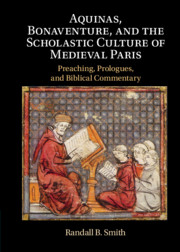 Aquinas, Bonaventure, and the Scholastic Culture of Medieval Paris
Aquinas, Bonaventure, and the Scholastic Culture of Medieval Paris Book contents
- Aquinas, Bonaventure, and the Scholastic Culture of Medieval Paris
- Aquinas, Bonaventure, and the Scholastic Culture of Medieval Paris
- Copyright page
- Dedication
- Contents
- Acknowledgments
- Introduction
- Part One Preliminaries
- 1 Preaching and Principia at the University of Paris
- 2 The Basic Elements of the Thirteenth-Century “Modern Sermon”
- 3 Principia and the Sermo Modernus
- Part Two Thomas Aquinas
- Part Three Bonaventure
- Appendix 1 Outlines of the Divisiones Textus of the Books of the Bible from the Inception Resumptio Addresses of Four Thirteenth-Century Masters
- Works Cited
- Index
3 - Principia and the Sermo Modernus
from Part One - Preliminaries
Published online by Cambridge University Press: 05 February 2021
- Aquinas, Bonaventure, and the Scholastic Culture of Medieval Paris
- Aquinas, Bonaventure, and the Scholastic Culture of Medieval Paris
- Copyright page
- Dedication
- Contents
- Acknowledgments
- Introduction
- Part One Preliminaries
- 1 Preaching and Principia at the University of Paris
- 2 The Basic Elements of the Thirteenth-Century “Modern Sermon”
- 3 Principia and the Sermo Modernus
- Part Two Thomas Aquinas
- Part Three Bonaventure
- Appendix 1 Outlines of the Divisiones Textus of the Books of the Bible from the Inception Resumptio Addresses of Four Thirteenth-Century Masters
- Works Cited
- Index
Summary
In the modern world, we don’t assume that sermons and book prologues should be done in the same style, or that book prologues and introductory lectures should share the same style, let alone that either of these should be written as sermons. Yet the sermo modernus style we have just described was used in all three types of principia distinguished in Chapter 2: introductory lectures, book prologues, and inception addresses. What order of development resulted in all three making use of the same style is unknown to us. Whether masters first developed a new method of introducing students to a book that would help them keep its sections in memory and then later found it useful for sermons, or whether a style of preaching was incorporated into the methodology of the classroom, we do not know. What we do know is that by the time Thomas and Bonaventure incepted as masters at Paris in 1256 and 1254 respectively, the sermo modernus style was accepted as the default mode for delivering principia of any type, written or oral, and no one seems to have questioned the practice.
- Type
- Chapter
- Information
- Aquinas, Bonaventure, and the Scholastic Culture of Medieval ParisPreaching, Prologues, and Biblical Commentary, pp. 67 - 76Publisher: Cambridge University PressPrint publication year: 2021
